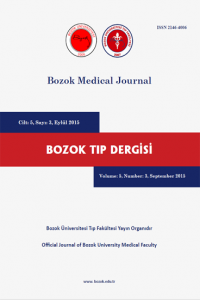Abstract
Amaç: Tiroidektomi olgularında retrospektif değerlendirme sonuçlarının sunulması amaçlandı.
Gereç ve Yöntem: Haziran 2010- Ekim 2014 tarihleri arasında opere edilen 193 hasta retrospektif olarak değerlendirildi. Hastaların demografik özellikleri, yapılan cerrahi operasyon tipi ve oluşan komplikasyonlar incelendi.
Bulgular: Toplam 193 hastanın 160’ı kadın (%82.9), 33’ü (%17.1) erkekti. En genç hasta 18, en yaşlı hasta 71 yaşındaydı. En sık cerrahi endikasyon 140 (%72.53) olgu ile toksik olmayan multinodüler guatrdı. 21 (%10.88) olguda rastlantısal malignite saptandı. Bir olguda kalıcı hipoparatiroidi oluştu. Kalıcı sinir hasarı gözlenmedi.
Sonuç: Nüks olgulara yapılan cerrahilerde komplikasyon oranı artmaktadır. Ayrıca rastlantısal malignite oranı göz önüne alındığında, total tiroidektominin primer olgularda uygun teknik olduğu düşünülmektedir.
Keywords
References
- Güney E. Tiroid neoplazmları. Güney E, editör. Tiroid ve Paratiroid Bez Cerrahi Hastalıkları. 1. Baskı. İstanbul: İyiişler Matbaacılık Ltd Şti.; 2008. p.93-104.
- Cusich EL, Krukowski ZH, Macintoch CA and N A Methason. Risk of neoplasia and malignancy in dominant thyroid swelling. BMJ 1991;303(6793):20-24.
- Anderson PE, Hurley PR, Rosswick P. Conservative treatment and long-term prophylactic thyroxine in the prevention of recurrence of multinodular goiter. Surg Gynecol Obstet 1990; 171(4):309-14
- Shindo ML. Benign tiroid hastalıklarına giriş. Güngör A, Urhan M, çeviri editörleri (Terris DJ, Gourin CG, eds.). Tiroid ve Paratiroid Hastalıkları Tıbbi ve Cerrahi Tedavi. 1. Baskı. İstanbul: Habitat Yayıncılık; 2010. p.53-63.
- Süslü N, Hoşal Ş. Tiroid nodülüne yaklaşım ve cerrahi endikasyonlar. Turkiye Klinikleri J Surg Med Sci 2007;3(49):5- POLAT ve ark.
- Tiroidektomi Retrospektif Analizi Bozok Med J 2015;5(3):33-6
Abstract
Aim: In this study, we aimed to present a retrospective evaluation of thyroidectomy in our patients.
Material and Methods: 193 patients operated between June 2010 and October 2014 was evaluated retrospectively. Demographic characteristics of the patients, type of the performed surgery and resulting complications were analyzed.
Results: Of a total of 193 patients, 160 were women (82.9%), 33 were male (17.1%). Among them, the youngest patient was 18 years old and the oldest patient was 71 years old. The most common indication for surgery was non-toxic multinodular goiter that is seen in 140 patients (72.53%). Incidental malignancies were found in 21 patients (10.88%). While permanent hypoparathyroidism occurred in one patient, the permanent nerve damage was not observed.
Conclusion: Complication rate increases following surgery that performed to recurrence cases. In addition, when considering the rate of incidental malignancies, total thyroidectomy is thought to be appropriate technic for primary cases.
Keywords
References
- Güney E. Tiroid neoplazmları. Güney E, editör. Tiroid ve Paratiroid Bez Cerrahi Hastalıkları. 1. Baskı. İstanbul: İyiişler Matbaacılık Ltd Şti.; 2008. p.93-104.
- Cusich EL, Krukowski ZH, Macintoch CA and N A Methason. Risk of neoplasia and malignancy in dominant thyroid swelling. BMJ 1991;303(6793):20-24.
- Anderson PE, Hurley PR, Rosswick P. Conservative treatment and long-term prophylactic thyroxine in the prevention of recurrence of multinodular goiter. Surg Gynecol Obstet 1990; 171(4):309-14
- Shindo ML. Benign tiroid hastalıklarına giriş. Güngör A, Urhan M, çeviri editörleri (Terris DJ, Gourin CG, eds.). Tiroid ve Paratiroid Hastalıkları Tıbbi ve Cerrahi Tedavi. 1. Baskı. İstanbul: Habitat Yayıncılık; 2010. p.53-63.
- Süslü N, Hoşal Ş. Tiroid nodülüne yaklaşım ve cerrahi endikasyonlar. Turkiye Klinikleri J Surg Med Sci 2007;3(49):5- POLAT ve ark.
- Tiroidektomi Retrospektif Analizi Bozok Med J 2015;5(3):33-6
Details
| Primary Language | Turkish |
|---|---|
| Subjects | Health Care Administration |
| Journal Section | Original Research |
| Authors | |
| Publication Date | October 14, 2015 |
| Published in Issue | Year 2015 Volume: 5 Issue: 3 |


